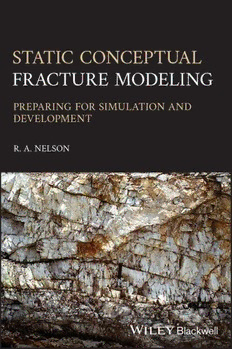
Static Conceptual Fracture Modeling: Preparing for Simulation and Development PDF
Preview Static Conceptual Fracture Modeling: Preparing for Simulation and Development
Static Conceptual Fracture Modeling ffirs.indd 1 09/17/2019 7:33:18 AM ffirs.indd 2 09/17/2019 7:33:18 AM Static Conceptual Fracture Modeling Preparing for Simulation and Development R.A. Nelson Broken N Consulting 1444 New Ulm Road Cat Spring, TX, US, 78933 ffirs.indd 3 09/17/2019 7:33:18 AM This edition first published 2020 © 2020 John Wiley & Sons Ltd All rights reserved. No part of this publication may be reproduced, stored in a retrieval system, or transmitted, in any form or by any means, electronic, mechanical, photocopying, recording or otherwise, except as permitted by law. Advice on how to obtain permission to reuse material from this title is available at http://www.wiley.com/go/permissions. The right of Ronald A. Nelson to be identified as the author of this work has been asserted in accordance with law. Registered Office(s) John Wiley & Sons, Inc., 111 River Street, Hoboken, NJ 07030, USA John Wiley & Sons Ltd, The Atrium, Southern Gate, Chichester, West Sussex, PO19 8SQ, UK Editorial Office 9600 Garsington Road, Oxford, OX4 2DQ, UK For details of our global editorial offices, customer services, and more information about Wiley products visit us at www.wiley.com. Wiley also publishes its books in a variety of electronic formats and by print‐on‐demand. Some content that appears in standard print versions of this book may not be available in other formats. Limit of Liability/Disclaimer of Warranty While the publisher and authors have used their best efforts in preparing this work, they make no representations or warranties with respect to the accuracy or completeness of the contents of this work and specifically disclaim all warranties, including without limitation, any implied warranties of merchantability or fitness for a particular purpose. No warranty may be created or extended by sales representatives, written sales materials or promotional statements for this work. The fact that an organization, website, or product is referred to in this work as a citation and/or potential source of further information does not mean that the publisher and authors endorse the information or services the organization, website, or product may provide or recommendations it may make. This work is sold with the understanding that the publisher is not engaged in rendering professional services. The advice and strategies contained herein may not be suitable for your situation. You should consult with a specialist where appropriate. Further, readers should be aware that websites listed in this work may have changed or disappeared between when this work was written and when it is read. Neither the publisher nor authors shall be liable for any loss of profit or any other commercial damages, including but not limited to special, incidental, consequential, or other damages. Library of Congress Cataloging‐in‐Publication data has been applied for: 9781119596936 [hardback] Cover Design: Wiley Cover Image: Photo courtesy of S. Serra Set in 10/12pt Warnock by SPi Global, Pondicherry, India 10 9 8 7 6 5 4 3 2 1 ffirs.indd 4 09/17/2019 7:33:18 AM I dedicate this volume to my professional society of choice during my career, The American Association of Petroleum Geologists. I have certainly been a member of other societies, but the AAPG is the one that I have supported over 40 years and that has supported me over that period as well. I have been an author, course instructor, reviewer, Distinguished Lecturer, Committee Chair, Trustee Associate and Executive Committee member over the years and have learned how to be an active professional from the example of other AAPG members. ffirs.indd 5 09/17/2019 7:33:18 AM ffirs.indd 6 09/17/2019 7:33:18 AM vii Contents Foreword xi Symbols and Abbreviations xiii Acknowledgments xv 1 Purpose and Scope 1 2 What Is a Static Conceptual Fracture Model and Why Do We Build It? 3 3 Fracture Model Creation Workflow 9 4 Gathering Natural Fracture Orientation and Intensity Data Directly 13 4.1 Outcrop Based Data 13 4.1.1 Requirements for Outcrop Selection 14 4.1.2 Data to Be Collected 14 4.1.3 What’s Real and Not 16 4.2 Core Based Data 16 4.2.1 Types of Core 18 4.2.2 Data to Be Collected 20 4.2.3 What’s Real and Not 22 4.2.4 Quantification 27 5 Gathering Natural Fracture Orientation and Intensity Data Indirectly 35 5.1 Bore Hole Image Log Based Data 35 5.1.1 Tool Types and Resolution 36 5.1.2 Data to Be Collected 38 5.1.3 Quantification 38 5.2 Remote Sensing‐based Data 40 5.2.1 Surface Based 40 5.2.2 Basement‐Based Geophysical Methods (Potential Fields or Gravity and Magnetic Data) 42 5.3 3D Seismic Fracture Data Collection 43 5.3.1 Detailed Structural Geometry 44 ftoc.indd 7 09/17/2019 7:32:57 AM viii Contents 5.3.2 Seismic Attributes 44 5.3.3 Passive Seismic and Hydraulic Fracture Monitoring 47 6 Analyzing the Natural Fracture Data Once Gathered 51 6.1 Correcting for the Difference Between Measurement Orientation and Fracture Set Intensity 51 6.2 Calibration 51 6.3 Determining Natural Fracture Origin from Fracture Distributions and Morphology 59 6.4 Mapping Natural‐fracture Orientation and Intensity 67 7 Gathering and Analyzing Structural Data 71 7.1 Structural Surface Maps and Sections 71 7.2 Analysis of Structural Surfaces 71 7.2.1 Discontinuity Analysis 71 7.2.2 Lineation Analysis 75 8 Gathering Constraints on Fracture Aperture 81 8.1 Unstressed 82 8.2 Partially Stressed 85 8.3 Fully Stressed 85 8.4 How the Various Aperture Measures Go Together 89 9 Creation of Natural Fracture Scaling Laws 91 10 Gathering and Analyzing Mechanical Property Distribution Data 95 10.1 Rock Modulus and How It Effects Deformation and Fracturing 96 10.2 Rigidity Modulus Distributions 100 10.2.1 Vertical Distribution in Wells 100 10.2.2 Horizontal Distribution in Wells 102 10.2.3 Map Distributions by Unit and Sub‐units 103 11 Locating Fracture Corridors 105 12 Rock Anisotropy and its Importance in Determining Dominant‐Fracture Orientation and Relative Intensity 111 13 Determine the In‐situ Stress Directions and Magnitudes and their Variation 115 13.1 SH Directions and Mapping 116 max 13.2 SH Directions with Depth 119 max ftoc.indd 8 09/17/2019 7:32:57 AM
